In this post I want to talk about a few below deck features we really liked about our former boats — Elizabeth, a Bristol Channel Cutter 28 and Daphne, a Nor’sea 27. As we search for our new boat and peruse the boat sales websites, we find that the features listed below have subconsciously become features we seek in our new boat. This is not a comprehensive list, but just a few of the standouts. The first installment of this series discussed things we loved about their hull and deck configurations.
1. Good Sea Berths:
Daphne’s aft cabin provided two ideal quarter berths. A single person sized bunk with walls on both sides. Easy in and out, and with plenty of extra length for stuff beneath your feet because no matter how hard I try, stuff invariably ends up there. These quarter berths, like traditional pilot berths are out of the traffic zone. Quarter berths are extra awesome because of their proximity to helm. While sleeping offshore, I wake up easily, and when lying in the quarter berth it’s real easy to find out what’s happening in the cockpit without getting up. A simple call up to the cockpit for reassurance that all is OK is effortless. Bad sea bunks are: wide, in the bow, perpendicular to the centerline, hard to stay in, and stuffy.
2. Head Location:
On Daphne the head was located to the left of the companionway ladder, and I loved it. Firstly, it’s easy to access from the cockpit. It avoids the long march in wet foul weather gear past sleeping crew with harnesses clanking, and the inevitable wave-stumbling “Oopsies… I’m sorry I planted my hand on your forehead – it wasn’t me, it was the wave” apology. Making my way to the bow of a pitching, rolling boat and into an odorific, poorly ventilated hot box of privacy isn’t on my bucket list.
Heads are usually lined in fiberglass and designed to double as a “shower”. For this reason, they make great wet lockers, and there’s no better place to store your foul weather gear ready to grab at a moments notice than at the companionway. Sometimes I prefer to think of the head as a wet locker that also just happens to have a toilet. Like good sea bunks, “easy in, easy out” is always a good feature of a head, especially when you’ve been holding it a long time as often happens when short handed. For us, the head near the companionway makes a lot of sense.
3. Galley:
I think u-shaped galleys works best. You can stand in a single location and reach just about everything, thereby avoiding bouncing with hands full between icebox and cutting board as the sea plays pinball with you. The galley gets hot, and an offshore dinner favorite, pasta, creates a lot of steam. Having the galley beneath the companionway allows for natural exhausting of both heat and steam right out the main hatch. And the ladder offers a place to wedge yourself against when the seas get feisty.
4. Handholds and Tight Spaces:
Huge expansive interiors look great at docks and entertain well, but are just a nightmare at sea. Handholds along the overhead are a start, but what’s best are things to lean your hip into as you walk thru the cabin with your hands full. Standing on the centerline of your boat, can you lean on anything and be hands free? On Elizabeth, the table usually works well for that – but are your table supports strong enough to support your weight in a seaway? In contrast to many of the newer production boats I’ve been aboard, traditional narrow, tight walking space are good things offshore.
5. Simple Systems:
We prefer manual everything. If it requires extra electric wiring, in the name of convenience, it’s bound to need maintenance, break down, and require money to repair in the name of inconvenience. Plumbing is one onboard system that is easy to keep simple. On board Elizabeth and Daphne the plumbing was 100% human powered. We used manual foot pumps, made hot water in the kettle, and got a little workout in by using the manual pump on the head. In fact, aboard Daphne Teresa removed the head altogether and used a bucket – pure and simple. Interacting with these systems on a daily basis with your own hands or feet, helps give warning when problems are developing. Oh while we’re on the subject, we also liked Elizabeth’s water tankage (75 gallons) was in the bilge, midships and on centerline.
6. The Threshold:
I notice a lot of what I’ve said as far as ideal location of the various parts and pieces tends to pile things up in the companionway area. It’s the heart of the boat. We both enjoy sitting in the companionway while on watch, our feet dangling down below, our heads above deck keeping a lookout – straddling the threshold. Don’t underestimate the importance of a comfy threshold, with a good view. Daphne had a good view from the threshold, but Elizabeth with her dinghy on the cabin house did not.
So these are just a few of the things we loved about our former boats, certainly far from an exhaustive list of things to consider when discussing offshore boats. We’d love to hear what offshore friendly features you like about your boats interiors in the comments.


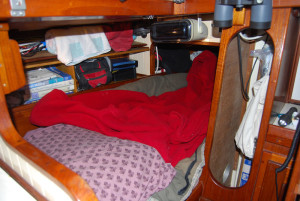
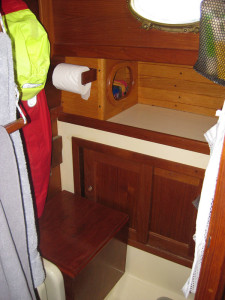

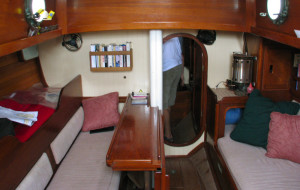
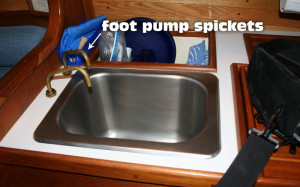
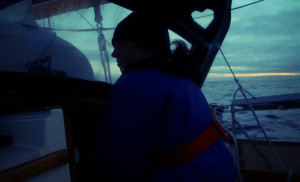
Comments 20
Some great ideas. The hand or foot pump helps conserve water on a long passage or just make the need to fill up less often. I’m impressed with the quanity of water you store in tanks instead of the smaller containers.
Beautiful boat
Those are all great points. Here are some additional areas we looked at.
1. Entrance from the companion way. Some boats we went onboard or even looking at online had litterally a ladder trough the companionway. We wanted a boat that was we get older we still have ease of climbing in and out of the boat.
2. Lots of hand holds to stay safe like you said in #4 and the head needed to be a head only. While in there it needed to be tight so that if you are bouncing around you can keep yourself stable by bracing up against the walls. The shower area needs to be easy to clean, will second as a wet locker and kitty litter area.
3. Storage is also a premium, but items need to stay where they are. In our last boat we had more shelves then cabinets and eventually on a long sail something will end up going flying onto the floor or acrosse the boat. Our current boat all cabinets are locking and any shelves have fiddels to keep items secure.
4. As for plumbing systems the easier the better. The problem is when you looking at new used boats it’s not going to be easy. There is usually hoses running everywhere and nothing is usually labeled. Teresa and her bucket has a lot of pluses. As for other plumbing all thru hulls need to be accessable and hopefully easy to work on. Working on the engine should be able to be performed without climbing on top of the thing, Access to the rear of the engine and stuffing box should also be realistic.
5. We avoided any boat with a fixed liner as well. Having removable ceiling panels to get access to backing plates or wiring was important to us.
6. I completely agree with #5 and keeping things simple, but again when buying a used boat the PO is most likely going to have systems that are not easy or just completely outdated. The most important thing about new systems is being able to shut them off and still be able to get to your destination. Enjoy sailing for what it is and don’t be depent on every modern advancement.
My water tankage (100 gallons worth) is in my bilge too, and while I like the idea of all that weight low and centered, I hate the idea of it occupying lots of bilge volume in the event the boat takes on water. It would all be in the living space that much faster…
My wife and I agree with many of your suggestions. We are live aboards and cruise the Chesapeake Bay. Like many live aboards, the head was usually a major issue. A close friend installed a composting head on his Mason 44. I followed suite shortly thereafter and found it to be no less than miraculous. There was no odor and was ecofriendly as well as simple. There are two commercial composters on the market. Natures Head and Airhead. Check it out.
Now that’s the kind of technology that makes me feel good about the direction the cruising world is going. Thank you for this comment, I had no idea such things existed.
Any idea if anyone has installed these to use their old holding tank as a liquids only tank to extend the times between pump outs? Is that even possible/smart?
My number one interior priority is one that I still don’t have, a good heating system. I can put up with allot, but being cold and wet is an invitation for Mr Grumpy to show up. In a few short days I will set off without a heater but I can guarantee I will have one by fall. No boat is perfect but any boat can be made that way. Movie please 🙂
We have some great quarter berths aft, but we actually prefer our fold down Concordia style berths. They’re just so much more comfy, our beds fold away, and by relaxing the downhaul they can be made great sea berths that just about cup your body. Still easy to check up on the cockpit action. Heck, even our pipe berth forward is pretty nice, but that’s because the whole boat is open (one bulkhead, no doors) and well-ventilated.
We actually like our head in the forepeak. Any smells are further away from the main living area and it’s certainly more private with an open layout (we have a bulkhead with a curtain between the forepeak and the main cabin.) The fact that it’s mounted to the side and the way the ceiling meets the sole makes it more comfortable to use underway, especially on a port tack. Plus, there’s always the bucket in the cockpit.
A wet locker near the companionway would be a nice feature, though.
I think every galley layout works pretty well, but the real difference between a good galley layout and a bad one is in the details. Everything should be accessible in a seaway and you should be able to brace, wedge, or strap yourself in easily. In our case in both the forepeak and the galley the ceiling meets the sole at such an angle that you can stand on a fairly level surface no matter what the boat is doing. This makes positioning yourself easy, but is a detail overlooked on other boats. There are dozens of little details like this that make us love our galley and we’ll be adding a few more tweaks as time goes on, too.
100% with you on handholds and tight spaces. Often those spacious boats lack stowage, too.
Simple is great. Our systems on Mimi Rose our like that: hand pumps, directly filled water tanks, etc. Things are fairly low maintenance and reliable as a result.
Can’t say I like hanging out in the threshold, but that’s probably because I almost went head first down a companionway once when on another boat and it ran aground. Alas, we’ll be building a nesting dinghy this winter that will take up residence between the mast and dodger on the cabin house, so it won’t be a great view much longer for us. Won’t miss towing a dinghy offshore or to windward one bit, though!
It’s not always talked about as an interior feature, but we love our wood hull. The smell, sound, condensation and the motion are nicer than with most glass boats. We’re also warmer when it’s cold and cooler when it’s hot. A heater with a fan positioned near it is a simple enough thing for those more extreme days in either direction. Having a ton of ventilation, lots of natural lighting and an open layout is great, too. You just feel like you’re in a much bigger space.
One thing that we don’t have, but would love is a comfy “chart table” that would double as an out-of-way work station in port. Being telecommuters, one of us is usually working on a laptop and it’s nice if the other person can have free run of the boat. We get this partially with just opening half of the dining table, but an extra space that didn’t interfere with movement around the boat would be tops. Another feature we don’t have, would be a small workbench, too. Perhaps we’ll find room for one in the forepeak someday.
Brilliant!
Hey Guys,
Ben I talked to you a year or two ago about the comparisons of the the NS27′ and the BCC28. I’ve been doing the research and crunching the wants and must haves. Last week I took the plunge. She is a PSC 37′. I never thought that I would go for a boat this large but I didn’t. I originally went to look at a Hans Christian 33 and while I was there why not take a look. I had never even considered this boat because the number was too big. Guess what, she is a small 37′. She has a canoe stern and a 10’10 beam. Her chain plates are external for good inspection and open side decks but she is narrow enough to offer good sheeting angles and turn of speed as well as an easy motion. She is hull number four of the PSC line with all rig and gear original. While I have to replace both standing and running rigging the foundation is bomb proof and I saved double that amount of cash by getting a hull that was ten years older. The big sell for me was the look of glee on the surveyors face as he walked around a thirty plus year old hull hitting it with a ball peen hammer saying “listen to this thing!” I believe that I paid about what you did for Elizabeth. She meets all your criteria except the head at the base of the companion way. A feature I was also looking for but I can see the advantages of not haveing your head across from the galley if it is not functioning properly.
Good luck with your search. There is a 81 PSC in Mass right now that could be had for a good price. All work required appears to be within the realm of a confident DIY’er.
Good luck, check it out, its reputation speaks for itself.
-Roger
Like it :). Eventhough there is a toilet – dont use it 😛
I sailed as a burser on a brig for two years and what you said about the head rings true. It’s the last thing you want to have problems with, especially while sailing. I’m looking into buying a live aboard right now and the one thing I will do first is install a composting toilet, it’s a step above the bucket that Teresa had aboard the Daphne but the same basic principle. A little more work is involved but as long as you don’t mind lugging the compost to dump every few weeks it’s a good choice. There are no moving parts really so you have one less thing to worry about. Unless you drop your bucket overboard….
Bursar*
An edit button would be nice. 🙂
I recently wrote a post about eliminating our boat’s head and using a bucket and/or “sani-bags” … kind of like a doggie bag for humans but it hardens immediately and doesn’t have any odors. It seems most readers thought I was nuts.
Would love the extra storage space that our holding tank now takes up. As far as a bucket … how did you handle crowded anchorages?
Trying to Keep It Simple on our 30 footer! =)
Cheryl,
We use the same type of product and found its worked very well. No oders or smells and no risk of someone clogging the system. It might not be the traditional way of things, but it works for us.
Dave
Glad to hear it Dave … thanks!
I really like your list, fortunately our Designer, Mark Ellis designed a boat that meets just about every thought… Mark’s attention to details is amazing including allowing drain able cabin sole below the companionway extending into nav station, the shower (our wet locker) and head. No wet gear forward into our main living space. Look forward to hearing what boat you have found.
I think the Pardey ‘ s boats are the best designs that really work. Their ideas were not totally original but they were time and sea tested.
James! What is it about the Pardey’s boats that you loved? Ben and I agree, they had a great boat. In fact, my first boat was a Lyle Hess design as well. And the boat Ben purchased and we later sailed together was the same design as the Pardey’s boat. It was a BCC, also designed by Lyle Hess. We agree, Lyle Hess boats are fantastic. However, it had its shortcomings and was no longer the ideal design for us. We looked for many features from the BCC in our next boat – some of them listed in this blog post. What would you add to the list? What did you love about the Pardey’s boat?
~Teresa
Lets bridge a couple critical matters which continuelly are ignored. Both involve our butts and cleanliness..made all the more important due to maintaining hygiene in a small space..plus reducing paper waste,the cost of paper & plain & simple – getting ‘it right’. Reduce tp use by using a butt sprayer – get a 48oz.Ace hardware single piece sprayer.. & learn the art of easy quick wash de’ ass. Haul less tp rolls, spend less $…find your lover’s body more yummy. Sprayers head is finely adjustable so user can find the right degree of rinse effectiveness…you poop,quick rinse & your back in business.Ive used for 4 yrs & still marvel how good it is. Drop pants,toot, spray, use small amt of tp to dry fanny area..even spray a bit of bowl to tidy up. Of course you may use sea water in sprayer..that salty wild water is excellent as a disinfectant.. one of lifes treasures.
Hi crew ! Not to be rude – just to tip you off , I’d suggest by upgrading your photogear, neatening & cleaning stains upon upholstery, organizing so clutter is zero’d out, without a doubt will create a better image as well as increase your business following. A galley should be spotless & organized. Any sign of clutter is likely to mean your unseen areas like engine bay,chain locker,head and chart table are worse. 1st impressions are critical indicators ?